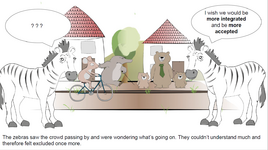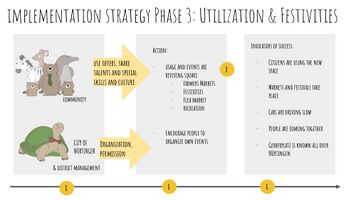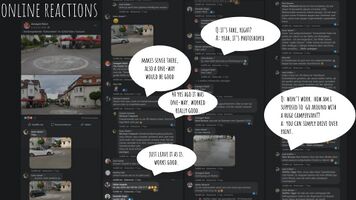LED2LEAP 2020 - Nuertingen Team 1
>>>back to working groups overview
| Area | Klein-Tischardt | |
| Place | Nürtingen | |
| Country | Germany | |
| Topics | Landscape architecture, community, landscape challenges | |
| Author(s) | Kathrin Berlinger, Valerie Gunzenhäuser, Lukas Klapprott, Paula Seifert | |

| ||
Landscape Democracy Rationale
The community has a lot of potential. It has an amazing location close to the city center and is located next to a river. It has a variety of different groups and beautiful landscape spaces. Yet those spaces are barely used because they are either hard to acces or its lacking ideas for a use and the different social groups are rather socially isolated from each other. We see the challenge in connecting the different groups and residents from the district Klein-Tischardt and to give them a feeling of community and identification with their district. The challenge is to bring them together in a landscape that allows people to interact with each other and with the landscape itself.
Location and scope
Phase A: Mapping your Community
Welcome to your community and its landscape
Klein-Tischardt is part of the city Nürtingen, located in South-Germany. It has strong boundaries such as a railway track, the big river "Neckar" and the "Steinach" stream. Most of the area is a housing area with a village-like character and there is a commercial area in the west. The citizens here are very mixed, there are different social classes, refugee housings and lots of elderly people due to a big nursing home.
Problematic is the main road Metzinger Straße as it is unsafe for bikes and pedestrians, also it’s dividing the area. Furthermore many non-residents park in the district because it's free and close to the city center.
Groups of actors and stakeholders in your community
There are a couple of groups that can be found in Klein-Tischardt. The residents are families, senior citizens, students and internationals like migrants and refugees. Then there are also some kind of institutions and sub-groups like the Fridays For Future group with their "Bunte Beete" project, the integration office, the rowing club which is highly frequented, the baptism church, a collective bar named "Silberburg" and some small businesses and companies.
With regard to the landscape there are some needs and aspirations the different groups share and some are more specific. In general, there should be space for meetings, neighborhood reinforcement and for events. Furthermore, lots of people would like to get a better acces to the riverside. Families and the kindergarden need play and leisure room. The Fridays For Future group already uses some space for an urban gardening area which they want to expand.
In general, the Fridays For Future group in Nürtingen is quite active and therefor visible. The rowing club attracts many people from all over the city and the silberburg used to be active a lot too. Unfortunately not every group is as visible as others. Refugees are mostly active in their own group, just as the students are. Retailers and the Integration Office aren't very present either.
Relationships between your actors and groups
In general the groups are willing to communicate with each other. There were community and planning workshops in the past that worked well and citizens also have the chance to voice their opinion and influence desicions made by the municipality. The municipality and investors mostly have the power of money and are powerfull when it comes to a final decision. But also political parties often speak up and influence with their opinions. A special right to be heard has the tire business at the Gerberplatz. It has been there for at least 50 years now and they own multiple houses in the neighborhood, wherefor they have a voice when it comes to the design of the Gerberplatz.
Summary of your learnings from the transnational discussion panel on April 22
We saw how many different and interesting projects are part of this year's LED2LEAP seminar. We learned about different kinds of analytic methods. For instance other groups used statistics and analyzed different subjects and levels. We got constructive comments: We should focus on the less known. We should try to find what we don’t know yet and to find the ‘unrepresented’ people and groups. And through that we might have a better chance to advance landscape democracy.If we look closer at the government system and demographics we might understand the democracy process better and find out who is not able to participate in democracy or participation methods. All in all we will look closer to what's visible and invisible.
Theory reflection
We found many theories from Section A interesting and we learned a lot. Especially the “people centred landscape concept” and “no landscape without knowledge” are interesting ways to look at the landscape with different views from different people. And we started to wonder which puzzle pieces of the landscape do we not know about. We also enjoyed to hear about “planning for development I and II” and “P.A.R. feedback loop” since we are landscape architecture design students and it gives us new ideas about the planning and design processes. But we have to admit that it was hard for us to use the theories for the community mapping task.
- People centred landscape concept: based on landscape knowledge. From the LED2LEAP Phase A Session 2: "rather than being mere assemblages of physical objects, landscapes are “constructed” in people’s minds." (Ipsen, D. 2012. Space, place and perception: The sociology of landscape, in (ed.) Bell, S., Sarlöv Herlin, I., Stiles, R., Exploring the Boundaries of Landscape Architecture, London and New York: Routledge) / (Kühne, O., 2013. Landschaftstheorie & Landschaftspraxis, Wiesbaden: Springer VS) / (Gailing, L., Leibenath, M., 2015. The Social Construction of Landscapes: Two Theoretical Lenses and Their Empirical Applications. Landscape Research, Volume 40, Issue 2)
- Planning for development: Discover - Plan - Build - Review and multiple iterations. Planning as a process that allows revision and improvement. (www.trustradius.com)
- Three columns model of contemporary democracy: The responsibility and engagement of every citizen is the base for the representative democracy, the direct democracy and the participatory democracy. (Christian Felber: The economy of the common good (Gemeinwohlökonomie), 2010, p. 109)
References
- www.neo.hfwu.de (material that was given to us for our design project)
- www.nuertingen.de
- "Bunte Beete" Nürtingen
Phase B: Democratic Landscape Analysis and Assessment
The Scene in your Story of Analysis
Our story is a fable and talks about our landscape challenge as it also analyses the different perspectives how the groups perceive their landscape. The fable takes place in Klein-Tischardt, specific places are the busy main road Metzinger Straße and the green Riverside. A big percentage of the residents are seniors and migrants, but there are other groups as well. The physical landscape isn’t satisfying yet for the residents and still has a lot of potential. How exactly is shown on the story slides.
The Actors in your Story of Analysis
We used animals as characters as it's typical for a fable. Each of the animals represents a certain group or stakeholder. The characters are described in the image below. We choose the mole to represent the elderly because it's blind and old people often have various disabilities as well. The bear was chosen to represent the family group because it gives the image of a strong, warm-hearted family bond. The tortoise is said to be wise and slow. That's why it represents the city council. The council is supposed to be wise and bureaucracy processes are often slow. Mice appear very active and quick and therefore represents young people like students in our story. The zebra has visibly different roots than the other rather native animals and therefore represents the migrants in Klein-Tischartd. All of the roles, except the city council are residents in Klein-Tischardt and they have different requirements for their district and landscape. All of the roles are equally important for the story. At the beginning of the story the characters aren't really connected to each other.
The Story of Analysis
In our fable the mole is triggered to complain by an insurmountable step. He wants things to get better for him and therefore becomes active. There are different ways to get active but in our story he wants things to change by talking to the city council. On his way there he meets other characters and they all have different demands for their landscape and they come along with the mole. The zebra (the migrants) see that something is going on, but because of their language barrier they don't know what's happening and are being left behind. In the end the crowd arrives in front of the city council tortoise.
The plot refers to our challenge in our community and hasn’t happened like that yet. The challenge is to connect the groups and bring them together, to form a community and to give the district an identity through the formed community and their landscape. The fable symbolises that to change something the people and groups need to come together. In the story they connect over complaining together. Of course there can be various reasons and ways to connect outside of the story. Also there are many other ways to make a change than only complaining to the city council. The main moral is, that the district and the feeling of living there can massively change if the people connect and act together for their community. But it’s also important to include and integrate all groups, so that no one is left behind like the zebra.
Reflect on your Story of Analysis
What did you carry? As methods we used classical walking around in the district and used our fantasy to empathize with the inhabitants. We tried to see the landscape with the eyes of various residents while exploring the environment. We also carry our knowledge about the district which we gained in the last weeks through LED2LEAP and our design project.
Why did you carry? We want to find out the different interests and needs of the inhabitants and how the groups act between each other. We also tried to find out which role we as planners have got in this project and which tools we need to make a change to a more inclusive and collaborative district and create usable and valuable open spaces.
How did you carry? An important attitude for us in our analysis is an open-minded and respectful approach and also creativity and courage to try new ideas and methods.
What remains after you've left? We hope it remains a new understanding of community and possibility to participate in the open space in the district and also some new nice spots in open space for the inhabitants.
Phase C: Collaborative Visioning and Goal Setting
The Scene in your Story of Visioning
The scene for the story of visioning is the map from our analysis-story, it´s the point, where the story of visioning establish and begins. So ones more it's the district of Klein-Tischardt with it´s most important spots. The place where the ideas and goals arise, of which a visioning comes out.
The Actors in your Story of Visioning
The actors are based on the characters of the analysis-story (the fable). The characters are animals which represents a certain group or stakeholder, they're described in the image below. The mole, the bear, the tortoise, the mice and the zebra are still the same characters as in the previous story. For the visioning phase we added the beaver and the "unknown". The beaver represents the planners and architects, which comes in the story to share own ideas and know-how with the community, to collect ideas from the community and do professional planning to take the wishes and ideas to builded reality. The "unknown" represents the actors in the story, which are still not seen or/and heared , aren't interestet or got no access to the process for any reason.
The Story of Visioning
Challenge
The condition in the community at the moment, is, that most of the people are living in their bubble and aren't connected to each other, so the democracy challenge is to change this condition (slide below). The goal setting process is the combination of the analysis of the whishes of the actors through workshop outcomes, emphasizing e.g. and the analysis of space and environement.
Goal setting process
To priorize the different goals, they are collected and sorted, for that a vision can be fomulated. In our story, for Klein-Tischardt the visions are Vision 1: Lively community and Vision 2: Safe + Accessible Klein-Tischardt.
From goals to vision
To get an strategy for realisation, we picked a cetrain goal and named 4 actions which could follow to achiev the goal. In our story, we choosed the goal: Create public spaces -> Possibilities for people to meet and connect. To describe the strategy, we used Action 1: Rezone & Design Gerberplatz (Square) and divided it in 3 phases, each with a timeline. So at the end of this phases the first action could be realized and the community steps futher to it's visions.
Reflect on your Story of Visioning
When formulating goals, it should be made sure everybody gets involved and no one is excluded. It can help, to connect multiple goals to a bigger one. Goals need to be realistic, specific and achievable. Characteristics of a “good” Vision: Visions need to be realistic. A good vision includes as many goals (and people) as possible.
Phase D: Collaborative Design, Transformation and Planning
Your Prototyping Action
We organised several actions of chalk painting. Some to adress the interest of the residents on their surrounding, but also some to give the residents the possibility to participate and interact, to draw their own ideas and awake their inner child while being creative. The actions relates to the vision of a lively community, and the goals of giving/getting an identity, having community events and giving ideas for the intelligent use of parking space.
The Evolution of Your Prototyping Action
The prototyping action idea evolved during our other university seminar in which we work on the same area. We were looking for a way to involve the residents under the conditions of Corona. We wanted to involve them and get feedback/reactions to some of our ideas for the landscape.
The actors for the action are: Us - We are planning and preparing the action. Nick - Who was part of the bridge action and helped to plan. Pedestrians - Who could choose to participate (chalk art action at the museum or participated unknowingly (bridge action) Museum - Gave permission for the usage of the museum square
Tools & methods: Communication through chalk - We were communicating our ideas through chalk but also the people could tell us their ideas with chalk. In another action traces of people were made visible by chalk.
You can find more details on the different actions on the slides further down.
The Plan Behind Your Prototyping Action
Our interaction was implemented with chalk. In most cases it was enough to let the drawings stand for itself. sometimes it took a few explanations. For the actions we needed the initiator to create the drawing, so as an observer to observe and analyze the result. The planing and action took over two weeks
The Realization of Your Prototyping Action
In the following pictures you can see, which interventions we actually performed. For our first intervention, the roundabout and the parklet you can even read some of the reactions from the citizens. We got a lot of feedback, positive such as negative. Most reactions on site were pretty well and the atmosphere varies from intervention to intervention. Most of the time people were quite interested.
Reflect on Your Prototyping Action
The change the actions creatde was that people are discussing, on site as well as online. We think, that the effect on site was more positive and created an bigger change for the people, who participated. Most of the participants had fun and liked it. One action even invited a band to spontaniously make some music. If we would do the actions again, we would rethink our advertisement for the actions and think of asking for permission at the municipality.











































